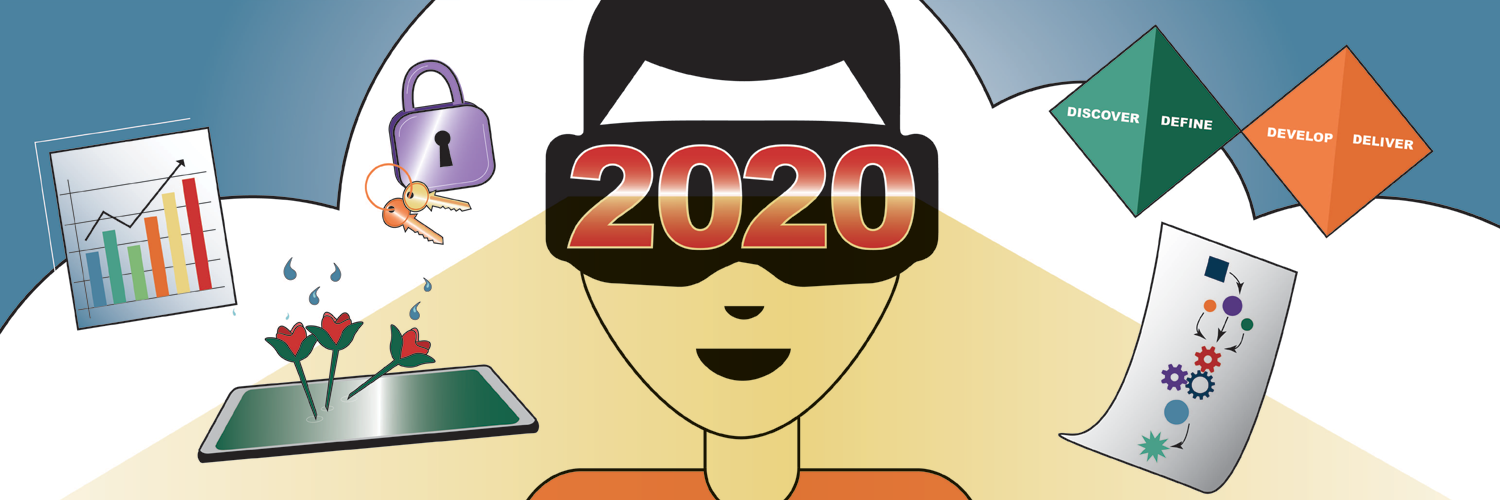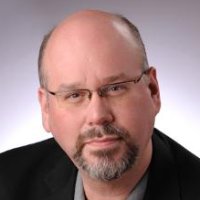
It’s hard to believe, but 2020 is almost upon us, wrapping up a decade of significant change in the technology space. For UX practitioners there are more opportunities than ever to practice our craft, as companies around the world discover the value of user-centered design.
While exciting, change presents challenges. Enterprises are moving more of their computing capacity to the cloud. Companies are automating more and more processes. Competing offerings in every industry have made UX a key differentiator. How features are communicated to users (and how they are supported throughout an application) is becoming a key differentiator. And evolving technical capabilities means designers have to keep pace with the new possibilities technology provides.
So, what should UX teams pay attention to next year? Here are some tech and design trends that can impact and inform what to focus on.
Hyperautomation
According to Gartner, which identified this as a top trend for 2020, hyperautomation combines machine learning (ML), packaged software, and automation tools to deliver work. Such enhanced automation is already beginning to be implemented in auto manufacturing.
The impact and opportunity for UX teams? Hyperautomation means more opportunities to leverage cross-platform solutions such as cloud computing and localized hardware to envision and design end-to-end automated experiences. Look to service design (more on this later) to become more important as a result.
With more processes being automated, effective communication and change management is key to a successful rollout. Change content and messaging is a must-have for hyperautomation to be fully realized in any enterprise.
How will legacy workers partner with such an approach? What are the benefits that hyperautomation brings? Defining these will help reassure staff who may be worried that automation is going to eliminate their jobs—when instead the intent is to empower them to focus on more high-value activities.
Multiexperience
Gartner also hypothesizes that through 2028, user experience will evolve significantly in how users interact with the digital world. AR, VR and mixed reality experiences will become a more accepted part of how people engage with technology.
All these new interaction models and experiences will beget new challenges in ensuring the technology maps to and mirrors how people engage with such technology. One recent example: how people play board games will be radically reimagined by technology from TiltFive (disclosure: this is run by some friends of mine). And the rumored Apple Glasses—which some say will launch by 2021—is a potential major disruptor in this space to pay attention to.

With more channels and touchpoints through which customers and users consume content, the need for supporting content is obvious—especially in the early stages when users may not be familiar with cutting-edge interaction models.
Creating Actionable Insights
More and more companies are leveraging data to inform decision-making. Building UIs/dashboards that provide actionable insights and recommendations from such data is a growing need UX teams can service.
Leveraging data to provide smart recommendations still requires such insights to be aligned with how people work and what they do. Making sure these analytical insights are relevant and useful is the perfect job for a UX practitioner to take on. Naturally, content modeling should be part and parcel of any efforts around defining smart dashboards and intelligent insights.
The best smart dashboards provide metrics that inform effective decisions. By applying research to understand what people need and how often, content can be properly modeled to support the end user (in whatever role he or she has in the organization) every day, week, and month. McKinsey’s recent Drumbeat of Digital report highlights how successful teams use such information to be more agile in their decision making. But beyond ensuring the right data is available, effort must be made to refactor that content to produce actionable insights.
Create actionable insights by building a framework of content intelligence that includes dashboards and reports as well as a regular cadence for re-evaluating content relevance. This allows you to build a foundation that provides tremendous value for your enterprise. Content Science’s teams can help you evaluate what content strategy can best help bring such insights to life.
Privacy and Accountability Around User Data
The use of analytics to inform the creation of a personalized or bespoke content experience is something myself and my design teams have pursued in the past. Now, because of GDPR, CCPA and other regulations, I have to be mindful about how I use data and for what purpose.
When in doubt, product and design teams need to run the use of personal data by their lawyers, and strongly question whether the use of such data is worth the potential legal and ethical risk. If such data is used, disclose the use of personalized data in clear and easy to understand language.
The messaging around how personal data is used should always be simple and accessible to reduce confusion and mitigate risk. Empathy is key. Privacy and security is a huge concern for users, and this should not be taken lightly. Using emphatic statements—”We WILL NOT use this data to market to you,” for example—will go a long way to not only reassuring users but also mitigating risk.
Finally, as you can see from the documentary “The Creepy Line” (a must-watch for anyone working in technology), respecting privacy while providing a personalized content experience requires the utmost delicacy. Personalizing content delivery is critical to making content easier to discover and use. Yet too much personalization comes off to many as crossing that creepy line.
As Gartner states: “Creating personalized messages and experiences requires intimate knowledge of customer journeys, relevant content that drives action, and technology that helps deliver and measure experiences … Focus on showing customers you can help them first.”
Connected Devices and Ubiquitous Internet Access
Another Gartner prediction regards the “intelligent edge,” in other words, smart and specialized devices that are always connected and leverage computing power from cloud services. The continuing availability of such devices means that experience designers can create even more focused content experiences. And with the declining cost and increased availability of ubiquitous Internet access, UX teams can craft and implement such experiences with more ease than ever before. It’s a boon for both users and UX.
There are challenges, however. Many of these devices are made by companies who don’t want their tech to be compatible with that of their rivals. They have created “walled gardens” where connectivity only works for their own hardware. Some companies are trying to break down these walls, but it’s an uphill climb.
Look for areas where open standards exist and consider these when it comes to designing a connected content experience. Identify areas where content needs to be developed (and existing content rules and models updated) to support implementation across devices.
Cloud Services
Decentralized computing power in the cloud is directly linked to the aforementioned above, but not every cloud provider is equal in what they bring to the table. Smaller providers can’t compete with the services provided by the big two, Amazon and Microsoft.
For UX practitioners and content professionals, it’s worth becoming familiar with these cloud-based services, so you can leverage them to create solutions for users.
Service Design and Design Thinking Continues to Gain Traction
Both service design and design thinking have gained significant traction in the enterprise space. This trend will continue as more decision-makers see the value in both techniques. Practitioners should focus on becoming adept at one or both of these disciplines, but also keep in mind that any process is a means to an end—not something to do “just because”.
Apply these approaches to produce actionable results that can improve how people work and what they do—the reason we do UX design in the first place. And identify areas where design thinking sessions can be applied to content strategy and other content needs.
Continued Demand for UX and Content Leadership
As more and more enterprise companies “stand up” their own design teams in-house, the need for managers and leaders for such teams is on the rise. Ambitious UXers should strongly consider getting management training to help fill these roles, and at the very least look for leadership roles on projects to sharpen their soft skills.
People in content strategy roles should also look to focus their soft skills to communicate the impact and importance of content in all projects. Content teams need leaders with vision and the ability to unite stakeholders. As Colleen Jones writes in The Content Advantage, leaders must “unify the content teams and capabilities under a common vision, advocate for turning that content vision into reality, and lead the team to take ownership of the vision.”
Conclusion
This is my third prediction article for Content Science Review, and while I’ve not been 100% on-point in the past, my batting average is pretty good. Above all, I see a consistent trend over the years—advances in technology are bringing more opportunities for UX designers and content strategists to positively affect people’s lives.
The key is to keep the end user in mind, to bring solutions to market that support how they work, and frame them in a way that makes the most sense. Never lose sight of who you are designing for, and focus on bringing the most value and impact to their lives.
Events, Resources, + More
The Ultimate Guide to End-to-End Content
Discover why + how an end-to-end approach is critical in the age of AI with this comprehensive white paper.
The Content Advantage Book
The much-anticipated third edition of the highly rated book by Colleen Jones is available at book retailers worldwide. Learn more!
20 Signs of a Content Problem in a High-Stakes Initiative
Use this white paper to diagnose the problem so you can achieve the right solution faster.
Upskill with Content Science Academy
Training for modern content roles through on-demand certifications + courses or live workshops.






Comments
We invite you to share your perspective in a constructive way. To comment, please sign in or register. Our moderating team will review all comments and may edit them for clarity. Our team also may delete comments that are off-topic or disrespectful. All postings become the property of
Content Science Review.